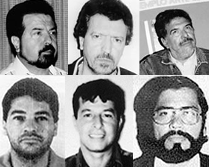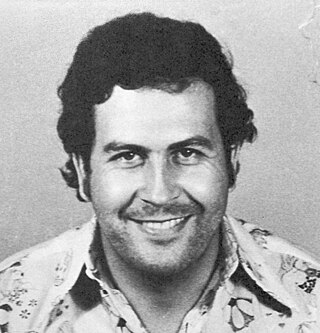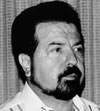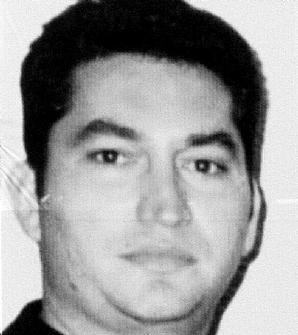
Pablo Emilio Escobar Gaviria was a Colombian drug lord, narcoterrorist, and politician, who was the founder and sole leader of the Medellín Cartel. Dubbed "the king of cocaine", Escobar was one of the wealthiest criminals in history, having amassed an estimated net worth of US$30 billion by the time of his death—equivalent to $70 billion as of 2022—while his drug cartel monopolized the cocaine trade into the United States in the 1980s and early 1990s.
Narcoterrorism, in its original context, is understood to refer to the attempts of narcotics traffickers to influence the policies of a government or a society through violence and intimidation, and to hinder the enforcement of anti-drug laws by the systematic threat or use of such violence. As with most definitions of terrorism, it typically only refers to non-state actors.

The Cali Cartel was a drug cartel based in southern Colombia, around the city of Cali and the Valle del Cauca. Its founders were the brothers Gilberto Rodríguez Orejuela, Miguel Rodríguez Orejuela and José Santacruz Londoño. They broke away from Pablo Escobar and his Medellín associates in 1988, when Hélmer "Pacho" Herrera joined what became a four-man executive board that ran the cartel.

The Medellín Cartel was a powerful and highly organized Colombian drug cartel and terrorist organization originating in the city of Medellín, Colombia, that was founded and led by Pablo Escobar. It is often considered to be the first major "drug cartel" and was referred to as such; due to the organization's upper echelons and overall power-structure being built on a partnership between multiple Colombian traffickers operating alongside Escobar. Included were Jorge Luis Ochoa Vásquez, Fabio Ochoa Vásquez, Juan David Ochoa Vásquez, José Gonzalo Rodríguez Gacha and Carlos Lehder. Escobar's main partner in the organization however was his cousin Gustavo Gaviria who handled much of the cartel's shipping arrangements and the more general and detailed logistical aspects of the cocaine trafficking routes and international smuggling networks which were supplying at least 80% of the world's cocaine during its peak. Gustavo, also known as León seems to have also had a strong hand in the cartel's unprecedented acts of narcoterrorism, right alongside his cousin Pablo and was considered to be second in command of the cartel and therefore one of Colombia's most wanted men, with both him and Escobar having arrest warrants pending from other nations where their criminal activity had spread to, such as in Spain and the U.S. Meanwhile, Pablo Escobar's brother Roberto Escobar acted as the organization's accountant. The cartel operated from 1976 to 1993 in Colombia (Antioquia), Bolivia, Panama, Central America, Peru, the Bahamas, the United States, as well as in Canada.

Nuestra Señora de la Santa Muerte, often shortened to Santa Muerte, is a new religious movement, female deity, and folk saint in Mexican folk Catholicism and Neopaganism. A personification of death, she is associated with healing, protection, and safe delivery to the afterlife by her devotees. Despite condemnation by the Catholic Church and Evangelical pastors, her cult has become increasingly prominent since the turn of the 21st century.

Narco-state is a political and economic term applied to countries where all legitimate institutions become penetrated by the power and wealth of the illegal drug trade. The term was first used to describe Bolivia following the 1980 coup of Luis García Meza which was seen to be primarily financed with the help of narcotics traffickers. Other well-known examples are Honduras, Guinea-Bissau, Mexico, Myanmar and Syria, where drug cartels produce, ship and sell drugs such as captagon, cocaine, heroin and marijuana.

Gilberto José Rodríguez Orejuela was a Colombian drug lord and one of the leaders of the Cali Cartel. Orejuela formed the cartel with his brother, Miguel Rodríguez Orejuela, José Santacruz Londoño, and Hélmer Herrera. The cartel emerged to prominence in the early 1990s, and was estimated to control about 80 and 90 percent of the American and European cocaine markets respectively in the mid-1990s. Rodríguez Orejuela was captured after a 1995 police campaign by Colombian authorities and sentenced to 15 years in prison. He obtained early release in 2002, and was re-arrested in 2003, after which he was extradited to the United States. There, he was sentenced to 30 years in prison, where he died in 2022.

Jesús Malverde, commonly referred to as the "generous bandit", "angel of the poor", or the "narco-saint", is a folklore hero in the Mexican state of Sinaloa.

José Gonzalo Rodríguez Gacha, also known by the nicknames Don Sombrero and El Mexicano, was a Colombian drug lord who was one of the leaders of the Medellín Cartel along with the Ochoa brothers and Pablo Escobar. At the height of his criminal career, Rodríguez was acknowledged as one of the world's most successful drug dealers. In 1988, Forbes magazine included him in their annual list of the world's billionaires.

Jorge Luis Ochoa Vásquez is a Colombian former drug trafficker who was one of the founding members of the notorious Medellín Cartel in the late 1970s. The cartel's key members were Pablo Escobar, Carlos Lehder, José Gonzalo Rodríguez Gacha, Gustavo Gaviria, Jorge Ochoa, and his brothers Juan David and Fabio.

Rodrigo Lara Bonilla was a Colombian lawyer and politician, who served as Minister of Justice under President Belisario Betancur, and was assassinated by orders of Pablo Escobar because of his work as Minister in prosecuting cocaine traffickers mainly belonging to the Medellín Cartel.

Juan José Esparragoza Moreno, commonly referred to by his alias El Azul, was a Mexican drug lord and member of the Sinaloa Cartel, Guadalajara Cartel and Juárez Cartel, three large and powerful criminal organizations. Originally a member of the Dirección Federal de Seguridad (DFS) police agency, he founded the Guadalajara Cartel in the 1970s along with other drug kingpins in Mexico. Following its disintegration in the late 1980s, he went on to lead the Juárez Cartel and eventually settled in the Sinaloa Cartel. He worked alongside Joaquín "El Chapo" Guzmán and Ismael Zambada García, once considered world's most-wanted, powerful and rich drug lords.
A drug lord, drug baron, kingpin, or lord of drugs is a type of crime boss, who is in charge of a drug-trafficking network, organization, or enterprise.

La Familia Michoacana, La Familia, is a Mexican drug cartel and organized crime syndicate based in the Mexican state of Michoacán. They are known to produce large amounts of methamphetamine in clandestine laboratories in Michoacan. Formerly allied to the Gulf Cartel—as part of Los Zetas—it split off in 2006. The cartel was founded by Carlos Rosales Mendoza, a close associate of Osiel Cárdenas. The second leader, Nazario Moreno González, known as El Más Loco, preached his organization's divine right to eliminate enemies. He carried a "bible" of his own sayings and insisted that his army of traffickers and hitmen avoid using the narcotics they produce and sell. Nazario Moreno's partners were José de Jesús Méndez Vargas, Servando Gómez Martínez and Enrique Plancarte Solís, each of whom has a bounty of $2 million for his capture, and were contesting the control of the organization.

Nazario Moreno González, commonly referred to by his alias El Chayo and/or El Más Loco, was a Mexican drug lord who headed La Familia Michoacana before heading the Knights Templar Cartel, a drug cartel headquartered in the state of Michoacán. He was one of Mexico's most-wanted drug lords.
This is a list of Mexico's 37 most-wanted drug lords as published by Mexican federal authorities on 23 March 2009. According to a BBC Mundo Mexico report, the 37 drug lords "have jeopardized Mexico national security."

Narcos is an American crime drama television series created and produced by Chris Brancato, Carlo Bernard, and Doug Miro. Set and filmed in Colombia, seasons 1 and 2 are based on the story of Colombian narcoterrorist and drug lord Pablo Escobar, leader of the Medellín Cartel and billionaire through the production and distribution of cocaine. The series also focuses on Escobar's interactions with drug lords, Drug Enforcement Administration (DEA) agents, and various opposition entities. Season 3 picks up after the fall of Escobar and continues to follow the DEA as they try to shut down the rise of the infamous Cali Cartel.

Narcos: Mexico is an American crime drama television series created and produced by Chris Brancato, Carlo Bernard, and Doug Miro that premiered on Netflix on November 16, 2018. It was originally intended to be the fourth season of the Netflix series Narcos, but it was ultimately developed as a companion series. It focuses on the development of Mexico's illegal drug trade, whereas the parent series centered on the establishment of Colombia's illegal drug trade. The series' second season premiered on February 13, 2020. On October 28, 2020, Netflix renewed the series for a third and final season but announced that actor Diego Luna would not be returning to reprise his role as Félix Gallardo. The third and final season premiered on November 5, 2021.
José Orlando Henao Montoya, also known by the nicknames 'Don H' and El Hombre del Overol, was a Colombian drug lord who was one of the leaders of the notorious Norte del Valle Cartel along with his brothers and associates like Iván Urdinola Grajales. During his career he was considered an extremely cunning criminal and in the words of his former associates the Rodriguez Orejuela brothers "More bloodthirsty than Pablo Escobar".















